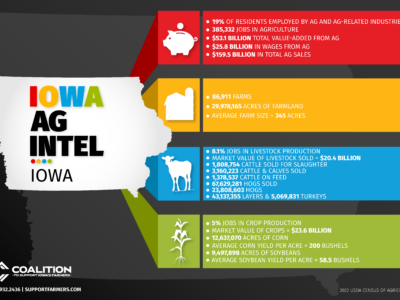NRCS Changes 590 Standard
10-31-2013 in Commodities
The Iowa Natural Resources Conservation Service (NRCS) has rolled out a revised 590 Nutrient Management Practice Standard. These changes affect livestock and poultry farmers who have taken, or are considering applying for, EQIP funding.
General changes include:
- Aligned better with the nutrient management conservation planning process.
- More consistent use of 4Rs language (the Right nutrient source applied at the Right rate in the Right place at the Right time) to describe nutrient management planning.
- Manure and commercial fertilizer management are treated more similarly than different.
Significant changes include:
- Adds municipal and industrial biosolids management as sources of plant nutrients as a purpose, plus related criteria.
- Ads manure with high ammonium content and MAP/DAP to the current anhydrous criteria for fall application (50 degrees or colder)
- Adds a “Rescue Nitrogen Application” section to the criteria, which allows over-application of N when weather causes a loss of N. Specifies evaluating the cause of the N loss, and formulating and evaluating management alternatives.
- Eliminates the requirement that sheet and rill erosion be controlled to Tolerable Soil Loss or “T”. Requires that when “T” is not met the P-Index be used and met.
- Specifies additional conservation practices that can be used to control and trap nutrients preventing them from being delivered to surface or ground water.
- “Sensitive areas” changes include: Adds tile inlets to the list of water quality sensitive areas. Sensitive area nutrient application restrictions apply to all P & N nutrient sources. 50’ filter strip can be substituted for the 200’ setback. (Editor’s note: manure can be applied within 200’ of a tile inlet IF it is incorporated within 24 hours.)
- Specifies that fields within well source water protection areas be identified on plan map
- Adds that manure testing will be done by a certified lab.
- Switches from “yield goal” language to “realistic yield potential” and provides simpler methodologies to estimate.
- Adds guidance to use adaptive nutrient management.
- Emphasizes calibration.
Other changes are:
- Adds “reducing odor” to the air quality purpose and provides considerations for planning.
- Adds criteria for organic crop production
- Adds specifications for precision agriculture.
- Adds organic matter analysis to each soil test (previously every 12 years).
- Removes the reference to using the Iowa 303d impaired waters list to trigger the use of the P-Index. The old criteria “Directly draining into…” a 303d listed water body was difficult to define and implement. The replacement trigger criteria are designed to require the use of the P-Index when there is a potential that the risk of P runoff is high.
- Adds a Leaching Index report which estimates the likelihood that water will leach through the field. Interpretations will be used for educational purposes.
- Promotes innovative use of cover crops to manage nutrients.
- Will be providing considerations in the form of a technical note to improve soil quality.
Areas of no changes from the previous 590 standard:
- The Iowa Phosphorus Index and interpretations remain the same.
- Applications of manure to frozen, snow covered, or saturated soils is precluded except for some emergency situations (but the language has been modified).
- No direct cap on soil test phosphorus.
For more information, the entire practice standard is available online. Questions can be directed to Eric Hurley, Iowa NRCS nutrient management specialist, at 515-323-2243 or eric.hurley@ia.usda.gov, or your county NRCS office or nutrient management consultant.
Recommended News

NEW STUDY SHOWS IOWA AGRICULTURE EVEN STRONGER
Iowa’s 86,911 family farms continue to be a key driver of Iowa’s economy, contributing 32 percent more to the state economy than in 2017, according to a new study commissioned...
Read More
Ehlers Family from Buena Vista County receive the Wergin Good Farm Neighbor Award
Iowa Secretary of Agriculture Mike Naig presented the Wergin Good Farm Neighbor Award to Mike and Michelle Ehlers and family, pork producers in Buena Vista County. The award was presented...
Read More
